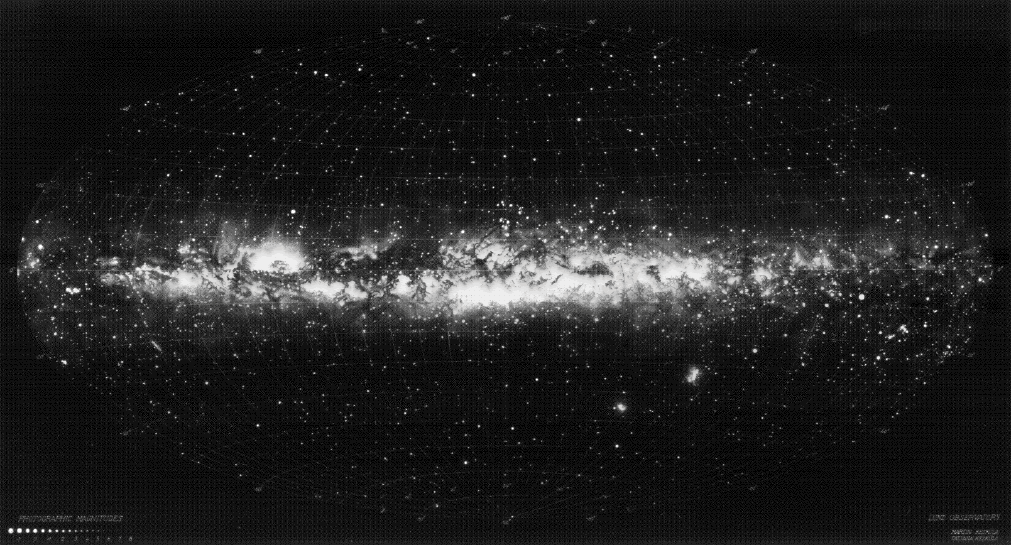
Tuesday, June 25th 2002. Reading: Cosmic Perspective Chapter 18

We understand today that the Milky Way is a gigantic collection of countless faint stars that lie in a disk and we lie in that disk as well and so we see it as a band encircling us in the sky.
The Milky Way galaxy is a huge, rotating, gravitationally bound system of about 400 billion stars.
In 1917 American Astronomer Harlow Shapley used a kind of variable star whose period of variability is related to its luminosity to measure the distances to the globular clusters. He found them arranged in a roughly spherical distribution centered not on the Sun but at a point ~8 kpc distant from the Sun. He reasoned that this must be the center of the Milky Way.
Astronomers began to realize that the obscuring dust and gas in the disk blocked out much of the light from most of the Milky Way making it only appear as if we were in the center. If you are in a dense fog even if you are little way into the edge of the fog you can't see very far into it and it looks rather uniform in all directions. Same thing.
Another demotion of Earth from a position of importance. Another step in what is called the Copernican Revolution.
Now we can begin to see what the overall structure of the Milky Way galaxy is.
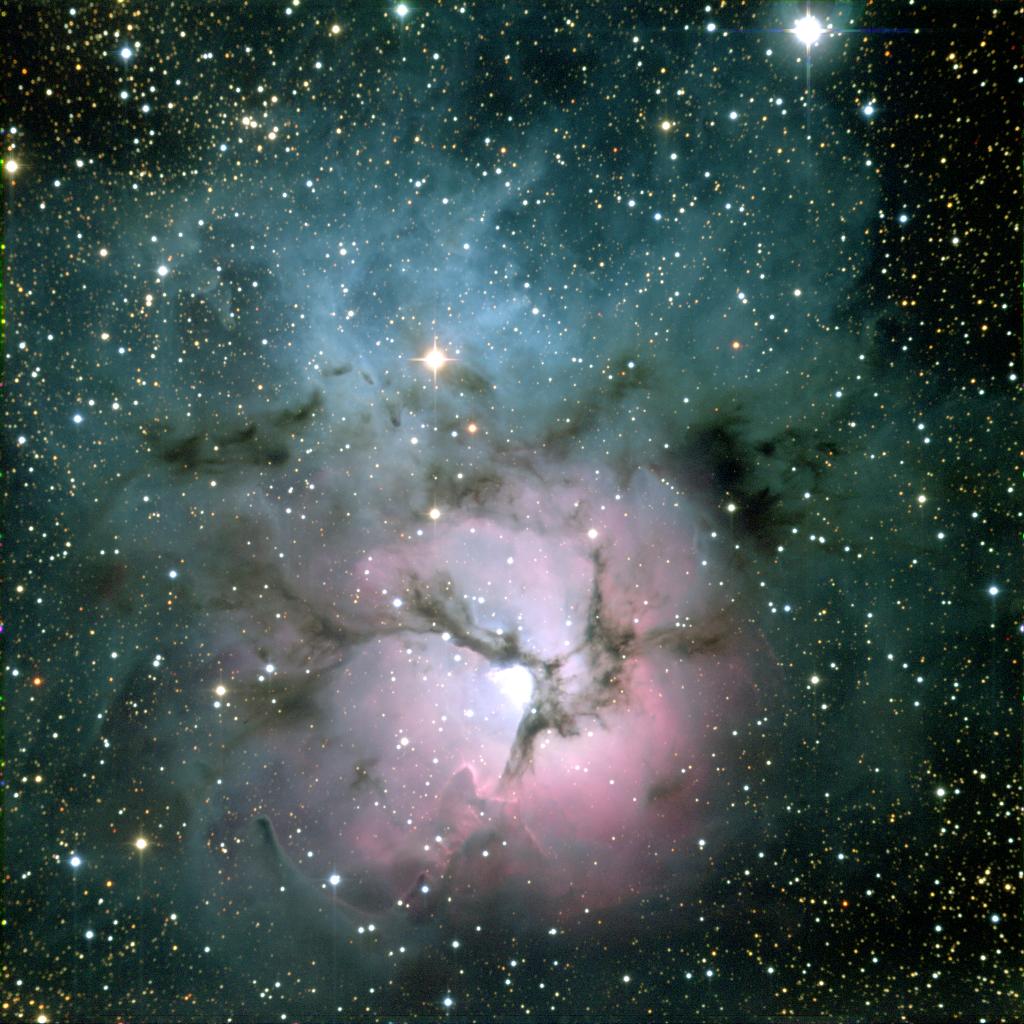 Emission Nebula: Gas is ionized by ultraviolet light from hot stars. Glows at optical wavelengths when electrons recombine with ions, or when electrons excite atoms and ions by colliding with them. Appear red because the most common electronic transitions are those with red wavelengths (not an indication of the temperature of the gas). Always in spiral arms.
Emission Nebula: Gas is ionized by ultraviolet light from hot stars. Glows at optical wavelengths when electrons recombine with ions, or when electrons excite atoms and ions by colliding with them. Appear red because the most common electronic transitions are those with red wavelengths (not an indication of the temperature of the gas). Always in spiral arms.
Reflection Nebula: Lots of dust and gas reflects (scatters) light from adjacent stars. Appears blue because the dust particles are about the size of the wavelengths of blue light and thus scatter the blue light more strongly than red light. Similar to why the sky is blue (no, it's not because if it were green we wouldn't know where to stop mowing). The sky is blue because nitrogen molecules in the air scatter blue light more strongly than red. Sunsets are red because the sunlight travels through so much atmosphere that most of the blue light scatters completely away and the sky near the sun appears red, purple and such. NOTE: The sunset is NOT red for the same reason that emission nebulae are red. Dark (absorption) Nebula: Blocks light. Generally have lots of dense gas and dust. More opaque than others. Gives the Milky Way its somewhat splotchy appearance. The dust and gas in the disk of the Galaxy absorb and scatter much light. This dims the light of stars passing through it, we call the effect extinction. The dust obscures the view of things behind it. Makes them dimmer (like looking at the headlights of a car through fog). Scatters away blue light making the star's light appear more red than it normally would. |
|
Gas is recycled in the Galaxy. It goes into forming stars and is returned during the death throws of stars enriched with heavy elements for the next generation of stars. It is a giant cycle of life. |
Newborn clusters are all in the spiral arms. These clusters contain the most luminous and blue stars. So even though the density contrast is not great the luminosity contrast is. O and B stars are as much as 105L![]() .
.
What are the spiral arms? Are they physical arms?
Winding Problem: Imagine that the arms are physical and we start them out in a line. Now we watch them wrap into a spiral due to the fact that the inner parts will revolve around the Galactic center faster than the outer parts. We can see that a nice spiral forms very quickly. The problem is that the spiral continues wind up tighter and tigher. In only a few revolutions the spiral gets extremely wound up. At its distance from the Galactic Center the Sun has gone around the Galaxy around 18 times. In so many turns the spiral pattern would be extremely wound up. This is not the case and such tight spirals arms are not observed in other galaxies.
 | 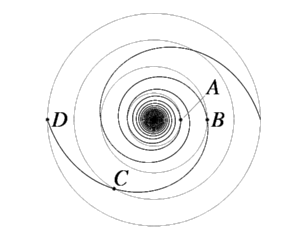 |
Density Waves: We now think that the spiral arms are not physical at all but are rather a pattern of overdensity rotating around the Galaxy. Such a pattern of overdensity is called a Density wave.
The concept of a density wave is very simple. Here's an analogy. Imagine that you are in a traffic helicopter hovering over a multilane freeway at night. Ahead you see that there is a truck moving slow in the far right lane. The cars behind it are slowing down ad bunching up behind it. The cars try to switch lanes to get around the truck. As they do they interupt the flow of traffic in the adjacent lanes as well. The result is a region around the truck of more cars bunched up together going slower than average. You can see this in the helicopter as the region where the tail lights all brighten as the drivers apply their brakes and they are squished closer together. The individual cars move through this bunched up region and new cars move in and take their place. The bunched up region persists. It moves along at about the speed of the slow truck. The bunched up region is an overdensity in cars and it is a density wave.
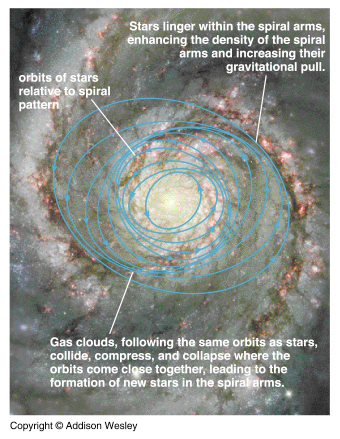 The spiral arms are regions where stars' and gas clouds' orbits bunch up closer to one another and the region becomes overdense. Stars go in and move out of the pattern, but the pattern persists and moves at its own rate.
The spiral arms are regions where stars' and gas clouds' orbits bunch up closer to one another and the region becomes overdense. Stars go in and move out of the pattern, but the pattern persists and moves at its own rate.
Since the region is overdense when gas clouds enter it they are compressed and begin to collapse gravitationally. This causes star formation to occur. New stars are born in the Spiral Arms. The new star clusters contain very luminous O and B stars. The O and B stars don't live for very long. The cluster might form at one edge of the spiral arm and then exit the other edge a few million years later. But that's all the longer the O and B stars live. They die before ever leaving the region of their birth. They die in supernova explosions. This is why massive star supernovae are only seen in spiral arms of galaxies. The other stars move out into the rest of the disk and over their lifetimes move in and out of other spiral arms.
|
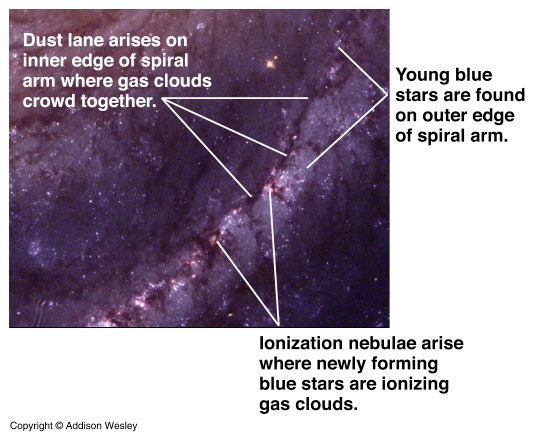 Spiral arms are only a pattern. Stars and gas clouds move in and out of them, and they are the locations of new star formation.
Spiral arms are only a pattern. Stars and gas clouds move in and out of them, and they are the locations of new star formation.
|
If orbits of stars are Keplerian then we can measure the mass interior to the orbit of a star from its speed.
Now we substitute the period into the expression for Kepler's 3rd law and get
We can write the result in two different ways to examine the mass of the Galaxy.
Mint = v2r/G
We can use the Doppler shift of radio emission from hydrogen gas in the disk of the galaxy to measure the rotation curve: the orbital velocity of the gas in the disk at a given radius. At the distance of the Sun we find that there should be Mint = 1011M![]() . If the average star has 0.5M
. If the average star has 0.5M![]() then there are about 200 billion stars within the Sun's orbit.
then there are about 200 billion stars within the Sun's orbit.
|
Rotation Curves: Measuring the rotation curve tells you how the matter is distributed in the Galaxy.
|
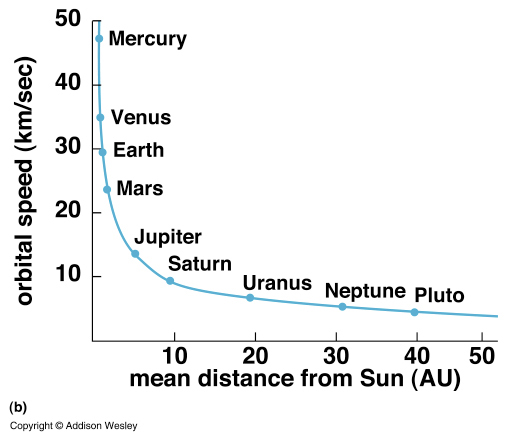 The Solar System follows a fall off of velocity with distance following Kepler's 3rd Law because it is centrally condensed.
The Solar System follows a fall off of velocity with distance following Kepler's 3rd Law because it is centrally condensed.
|
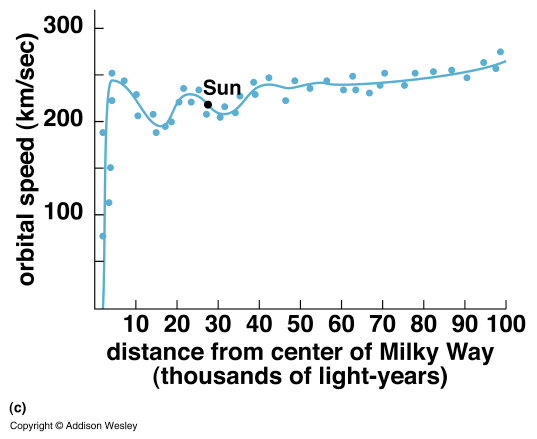 The rotation of curve of the Galaxy is initially straight (Bulge rotates like a solid body), then Keplerian for a short distance, then it flattens off at large radius.
The rotation of curve of the Galaxy is initially straight (Bulge rotates like a solid body), then Keplerian for a short distance, then it flattens off at large radius.
The fact that the rotation curve is approximately flat out to very large radii implies that the mass of the Galaxy grows linearly with distance beyond the Sun's orbit... Yet we do not see enough stars out there to account for all of this mass. The mass must therefore be mostly invisible --> Dark Matter What is it? Black Holes? Neutrinos? Brown Dwarfs? Exotic Particles? Jello Pudding Pops? |
MACHOs: MAssive Compact Halo Objects
"Jupiters", Brown Dwarfs, Red Dwarfs (M and L stars), White Dwarfs, Neutron Stars, Black Holes. Look for these using gravitational lensing of light of stars in LMC.
WIMPs: Weakly Interacting Massive Particles
Neutrinos, Axions, ?
All other spiral galaxies also have flat rotation curves implying the same thing. ~90% of the mass of the Galaxy is Dark Matter
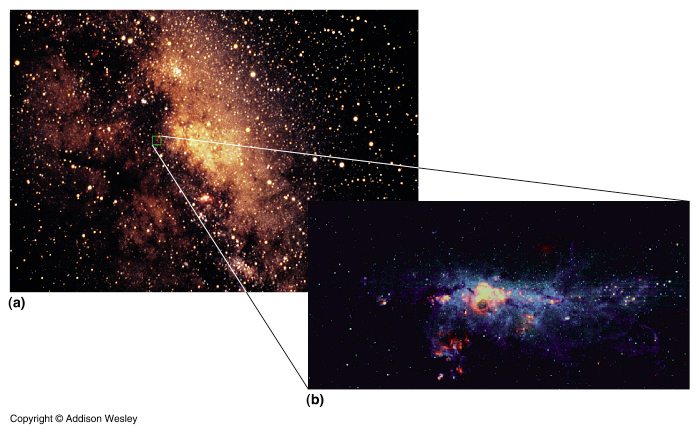 The central few light years of the Galaxy are obscured by gas and dust in visible light, so we cannot see what is going on in there.
The central few light years of the Galaxy are obscured by gas and dust in visible light, so we cannot see what is going on in there.
|
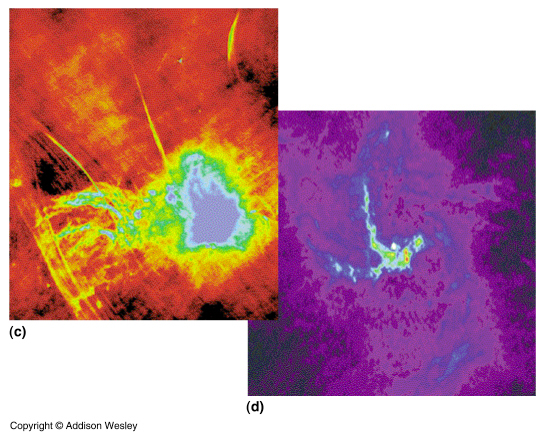 But in infrared and radio light we can see some rather remarkable things. There is a great deal of gas swirling about at very fast speeds very near the center. In the infrared we can see stars moving in extremely fast orbits about the center.
But in infrared and radio light we can see some rather remarkable things. There is a great deal of gas swirling about at very fast speeds very near the center. In the infrared we can see stars moving in extremely fast orbits about the center.
|
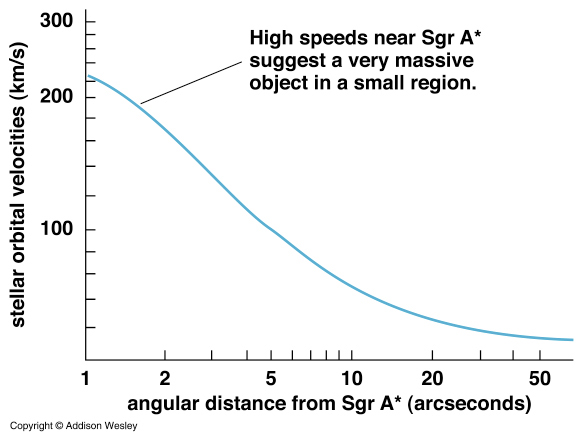 Using the Doppler shifts of the gas along with the proper motions of the stars allows us to determine their orbital velocities. Hence we can calculate the mass of the object that these stars and gas are all orbiting.
Using the Doppler shifts of the gas along with the proper motions of the stars allows us to determine their orbital velocities. Hence we can calculate the mass of the object that these stars and gas are all orbiting.
The analysis suggests something with about 2.5 Million times the mass of the Sun inside a volume only 3 Light-Years across. ---> Black Hole. |
Return to Class Notes Page